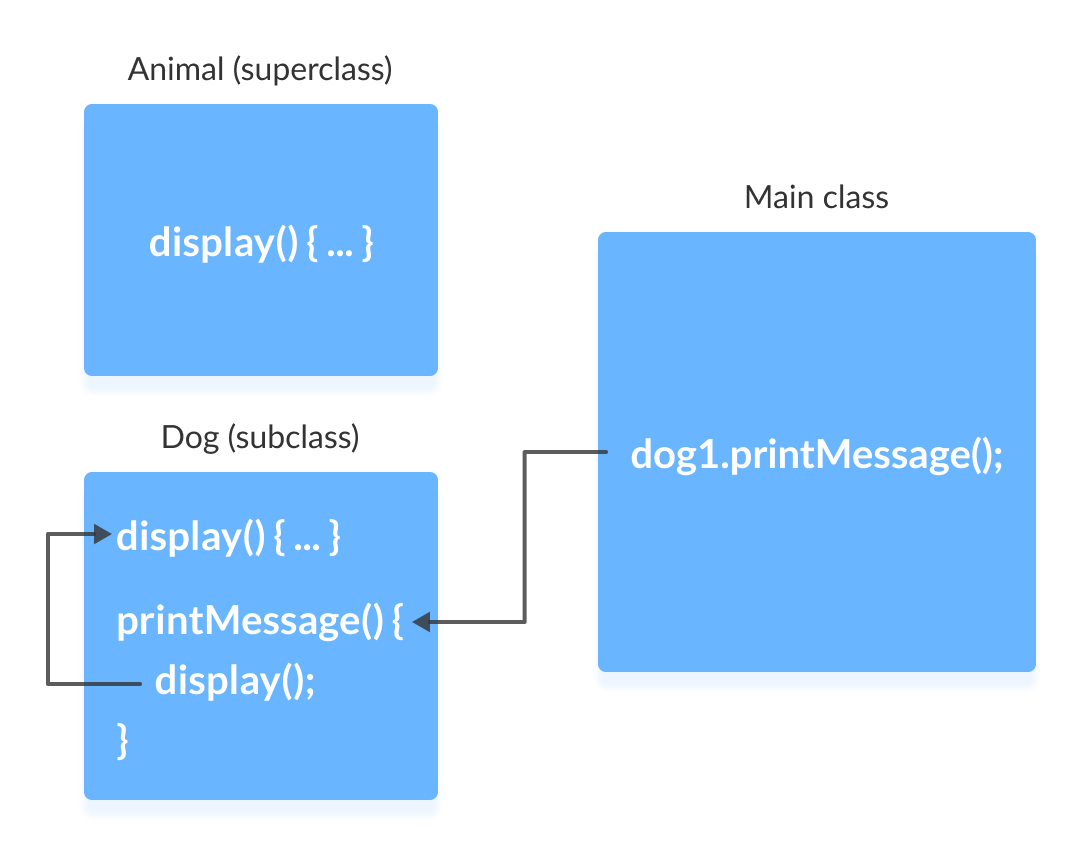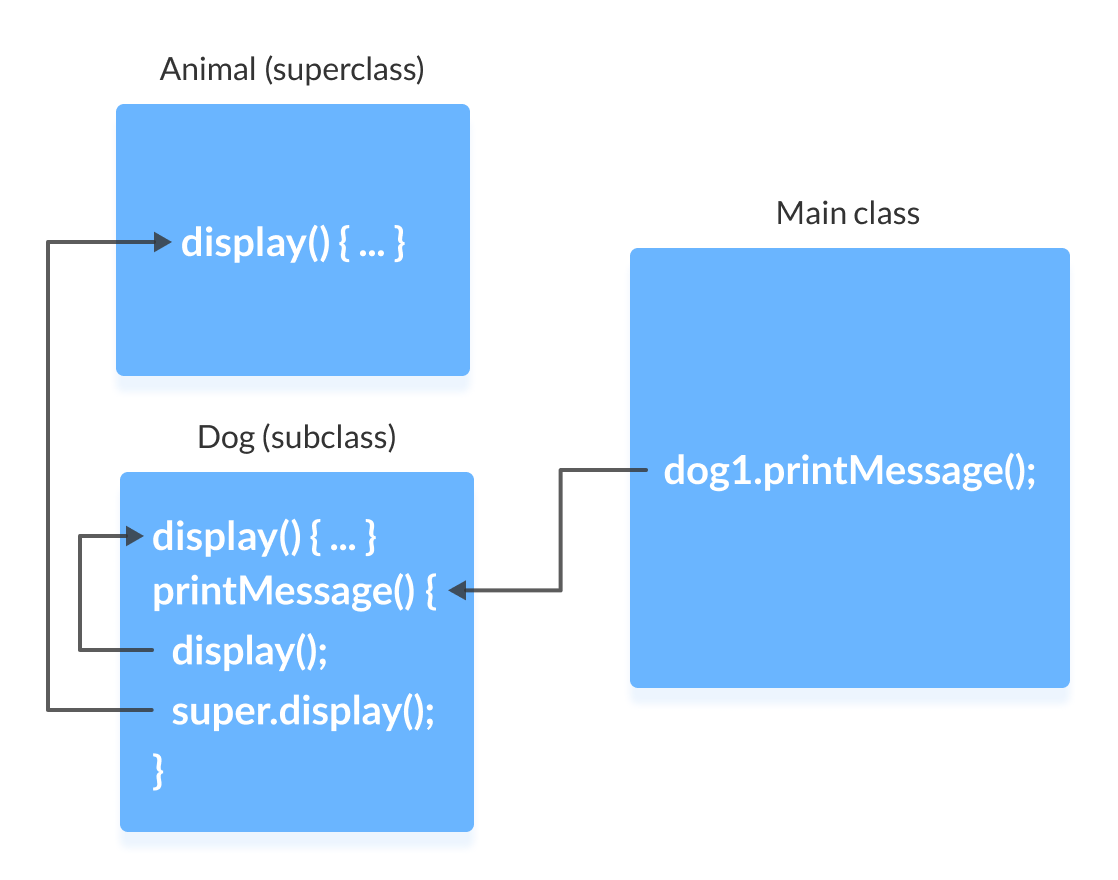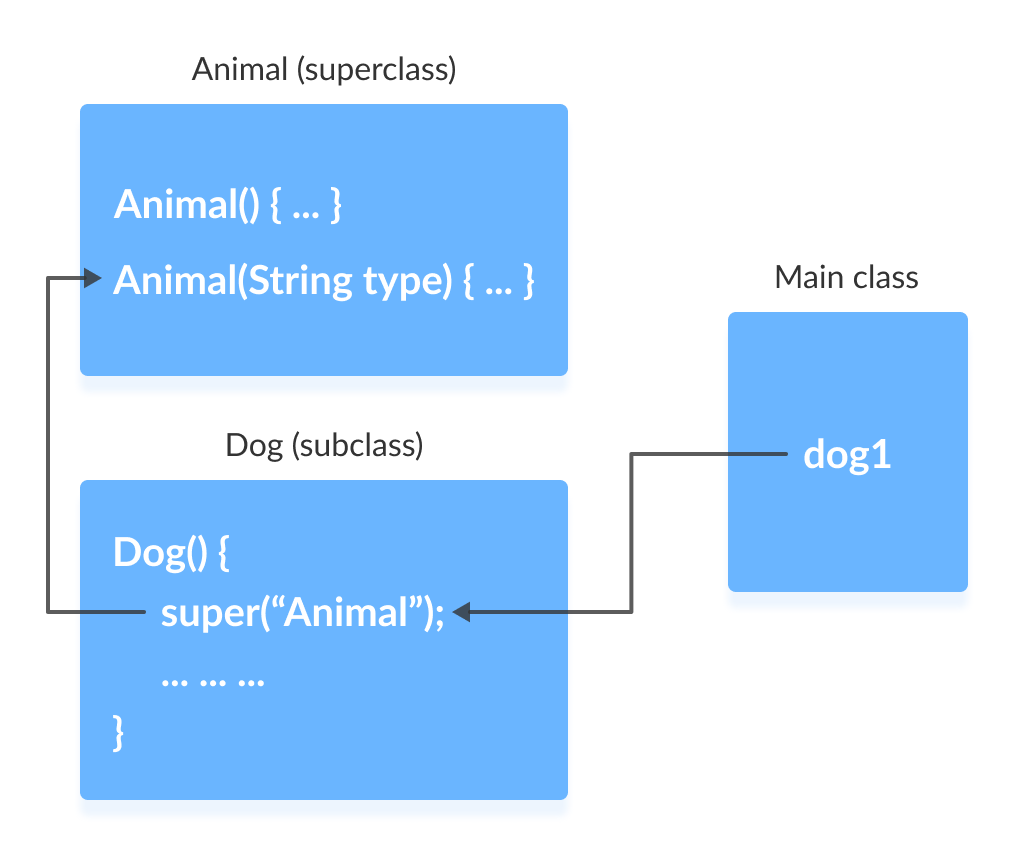Java中的super关键字在子类中用于访问超类成员(属性,构造函数和方法)。
在学习super关键字之前,请确保了解Java继承。
超级关键字的用途
- 调用在子类中重写的超类的方法。
- 如果超类和子类都具有相同名称的属性,则访问超类的属性(字段)。
- 从子类构造函数中显式调用超类no-arg(默认值)或参数化构造函数。
让我们了解所有这些用途。
1.超类的访问重写方法
如果在超类和子类中都定义了相同名称的方法,则子类中的方法将覆盖超类中的方法。这称为方法覆盖。
示例1:方法覆盖
class Animal {
// overridden method
public void display(){
System.out.println("I am an animal");
}
}
class Dog extends Animal {
// overriding method
@Override
public void display(){
System.out.println("I am a dog");
}
public void printMessage(){
display();
}
}
class Main {
public static void main(String[] args) {
Dog dog1 = new Dog();
dog1.printMessage();
}
}
输出
I am a dog
在此示例中,通过使对象Dog1为Dog类,我们可以调用其方法printMessage() ,然后执行display()语句。
由于在两个类中都定义了display() ,所以Dog子类的方法将覆盖Animal的超类方法。因此,将调用子类的display() 。

如果必须调用超类的重写方法怎么办?
如果需要调用超类Animal的重写方法display() ,则使用super.display() 。
示例2:超级调用超类方法
class Animal {
// overridden method
public void display(){
System.out.println("I am an animal");
}
}
class Dog extends Animal {
// overriding method
@Override
public void display(){
System.out.println("I am a dog");
}
public void printMessage(){
// this calls overriding method
display();
// this calls overridden method
super.display();
}
}
class Main {
public static void main(String[] args) {
Dog dog1 = new Dog();
dog1.printMessage();
}
}
输出
I am a dog
I am an animal
在这里,上述程序是如何工作的。

2.超类的访问属性
超类和子类可以具有相同名称的属性。我们使用super关键字访问超类的属性。
示例3:访问超类属性
class Animal {
protected String type="animal";
}
class Dog extends Animal {
public String type="mammal";
public void printType() {
System.out.println("I am a " + type);
System.out.println("I am an " + super.type);
}
}
class Main {
public static void main(String[] args) {
Dog dog1 = new Dog();
dog1.printType();
}
}
输出 :
I am a mammal
I am an animal
在此示例中,我们在超类Animal和子类Dog中都定义了相同的实例字段类型 。
然后,我们创建了Dog类的对象dog1 。然后,使用该对象调用printType()方法。
在printType() 函数内部,
- type是指Dog类的属性。
- super.type是超类Animal的属性。
因此, System.out.println("I am a " + type); 我是哺乳动物 。并且, System.out.println("I am an " + super.type);版画我是动物 。
3.使用super()访问超类构造函数
众所周知,创建类的对象时,将自动调用其默认构造函数。
要从子类构造函数中显式调用超类构造函数,我们使用super() 。这是super关键字的一种特殊形式。
super()只能在子类构造函数中使用,并且必须是第一条语句。
示例4:使用super()
class Animal {
// default or no-arg constructor of class Animal
Animal() {
System.out.println("I am an animal");
}
}
class Dog extends Animal {
// default or no-arg constructor of class Dog
Dog() {
// calling default constructor of the superclass
super();
System.out.println("I am a dog");
}
}
class Main {
public static void main(String[] args) {
Dog dog1 = new Dog();
}
}
输出
I am an animal
I am a dog
在这里,创建Dog类的对象dog1时,它将自动调用该类的默认或无参数构造函数。
在子类构造函数中, super()语句调用超类的构造函数并在其中执行该语句。因此,我们得到的输出是动物 。

然后,程序流返回到子类构造函数,并执行其余的语句。因此, 我将是一条狗将被印刷。
但是,并非必须使用super() 。即使在子类构造函数中未使用super() ,编译器也会隐式调用超类的默认构造函数。
那么,如果编译器自动调用super(),为什么还要使用冗余代码呢?
如果必须从子类构造函数中调用超类的参数化构造函数(带有参数的构造函数) ,则是必需的。
参数化的super()必须始终是子类的构造函数主体中的第一条语句,否则,将出现编译错误。
示例5:使用super()调用参数化构造方法
class Animal {
// default or no-arg constructor
Animal() {
System.out.println("I am an animal");
}
// parameterized constructor
Animal(String type) {
System.out.println("Type: "+type);
}
}
class Dog extends Animal {
// default constructor
Dog() {
// calling parameterized constructor of the superclass
super("Animal");
System.out.println("I am a dog");
}
}
class Main {
public static void main(String[] args) {
Dog dog1 = new Dog();
}
}
输出
Type: Animal
I am a dog
编译器可以自动调用no-arg构造函数。但是,它不能调用参数化的构造函数。
如果必须调用参数化的构造函数,则需要在子类构造函数中显式定义它。

请注意,在上面的示例中,我们显式调用了参数化构造函数super("Animal") 。在这种情况下,编译器不会调用超类的默认构造函数。